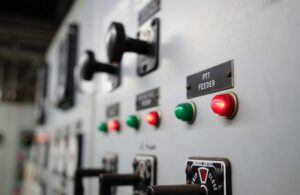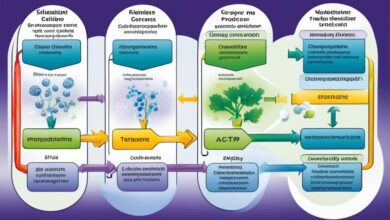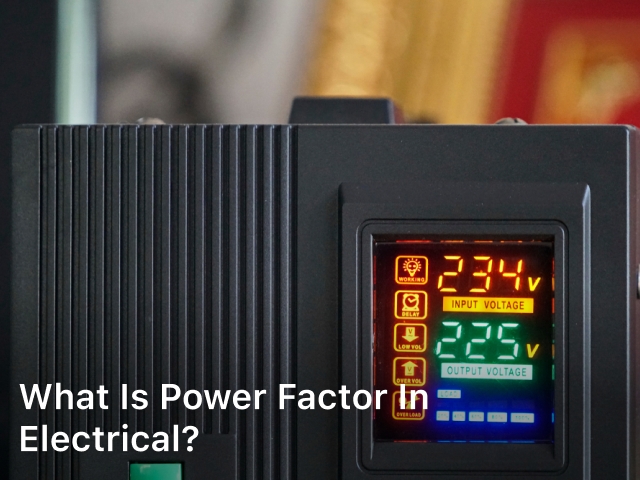
greentechinnovate.com. Power Factor leading or Lagging in Current State? – Uncover the essential differences between Power Factor leading or Lagging. Explore their impact on your power system’s performance with us.
Power Factor Leading or Lagging
As power systems become increasingly complex, power factor becomes an important factor to consider in maintaining a stable and efficient electrical system. Power factor refers to the ratio of real power to apparent power in an electrical system.
It measures how effectively electrical power is being utilized by the system. A power factor of one indicates that all the power is being used effectively. But a power factor of less than one means that the system is not using all the power it is receiving, which can lead to inefficiencies and increased costs.
There are two types of power factor: leading and lagging. These terms are used to describe the phase difference between the voltage and current in an AC circuit. A leading power factor means that the current leads the voltage, while a lagging power factor means that the current lags the voltage.
Understanding the difference between a leading and a lagging power factor is essential in maintaining a healthy electrical system. In the following sections, we will discuss in detail what power factor is, the factors that influence it, the impact it has on power systems, and how we can correct it.
Key Takeaways:
- Power factor is the ratio of real power to apparent power in an electrical system.
- A power factor of less than one indicates that the system is not using all the power it is receiving.
- There are two types of power factor: leading and lagging.
What is Power Factor?
Before we delve into the differences between leading and lagging power factors, let’s first define what power factor is and how it is calculated. Power factor is a measure of how efficiently electrical power is being used in a system. It is the ratio of real power (the power that is actually doing useful work) to apparent power (the total power supplied to the system).
To calculate power factor, we use the formula:
| Power Factor = | Real Power (W) | Apparent Power (VA) |
|---|
The result of this calculation will be a decimal or a percentage. A power factor of 1 (or 100%) means that all the power supplied to the system is being used to do useful work. A power factor less than 1 (or less than 100%) means that some of the power is being wasted.
So, how do we know if our power factor is leading or lagging? A leading power factor occurs when the load (i.e. the device using the power) is capacitive, meaning it stores electrical energy. A lagging power factor occurs when the load is inductive, meaning it uses electrical energy to produce a magnetic field.
It’s important to note that power factor can be positive or negative, depending on the phase relationship between the voltage and current in the system. A positive power factor means that the current is in-phase with the voltage, while a negative power factor means that the current is out-of-phase with the voltage.

Leading Power Factor
When the current waveform leads the voltage waveform in a power system, it is said to have a leading power factor. A leading power factor can occur when the load is capacitive in nature, meaning it draws current that leads the voltage.
A negative power factor is also considered a leading power factor. A negative power factor indicates that the load is consuming power instead of supplying it back to the system. This can occur when the load includes devices such as induction motors, which draw reactive power from the system.
A leading power factor can have both positive and negative effects on the power system. On the positive side, it can improve voltage regulation and reduce losses in the transmission system. However, if left uncorrected, a leading power factor can result in overloading of transformers and generators, leading to decreased overall efficiency of the system.
Effects of Leading Power Factor on Power System
| Impact | Effect |
|---|---|
| Voltage drop | Decreased voltage level in the transmission and distribution system, leading to inefficiencies and reduced performance of equipment. |
| Increased Line Losses | The current drawn by the load is out of phase with the voltage, causing increased line losses. |
| Reduced System Capacity | Leading power factor can cause overloading of transformers and generators, reducing the overall capacity of the system. |
Lagging Power Factor
When the power factor of a system is negative, it is said to have a lagging power factor. This means that the current lags behind the voltage, resulting in an inefficient use of power. A lagging power factor is common in systems where there are inductive loads, such as motors and transformers.
In a lagging power factor system, the amount of power that the load actually consumes is less than the apparent power. This is because the reactive power that the inductive load produces is not used by the system and is wasted. The wasted power puts an unnecessary burden on the power system, resulting in higher energy bills and reduced efficiency.
Lagging power factor can cause a number of problems in electrical systems, including voltage drops, overheating of equipment, and damage to motors and other electrical components. This makes it critical to manage and maintain a balanced power factor in order to avoid these issues and optimize system performance.
To manage a lagging power factor, there are several solutions that can be implemented, including the use of capacitors and inductors. These corrective measures can help to improve the power factor and ensure that the energy being consumed is efficiently utilized.
Factors Influencing Power Factor
Power factor can be influenced by a variety of factors, including the type of load, the type of equipment, and the operating conditions of the power system. Understanding these factors is essential in managing power factor and optimizing the efficiency of electrical systems.
Type of Load
The type of load connected to the power system can affect the power factor. Resistive loads, such as incandescent lamps and electric heaters, have a power factor of 1.0, meaning they do not affect the power factor.
Capacitive loads, such as motors and fluorescent lamps, have a leading power factor, meaning they reduce the reactive power demand of the system. Inductive loads, such as transformers and induction motors, have a lagging power factor, meaning they increase the reactive power demand of the system.
Type of Equipment
The type of equipment used in the power system can also affect the power factor. Older equipment, such as transformers and motors, may have a lower power factor than newer, more efficient equipment. Power factor correction equipment, such as capacitors, can be installed to improve the power factor of older equipment and reduce reactive power demand.
Operating Conditions
The operating conditions of the power system can also affect the power factor. Inconsistent voltage levels, unbalanced loads, and high levels of harmonics can all contribute to a lower power factor.
Proper maintenance and monitoring of the power system can help identify and address these issues, improving the power factor and overall efficiency of the system.
By understanding and managing these factors, we can optimize power factor and improve the efficiency and reliability of electrical systems.
Power Factor Correction
Managing power factor is critical to improving the efficiency of electrical systems. When the power factor is lagging, it means that the reactive power is higher than the active power, resulting in a less efficient system. Power factor correction techniques can be used to balance out the reactive and active power, resulting in a more efficient system.
One way to correct power factor is by installing capacitors. Capacitors can be added to the system to absorb the reactive power, balancing out the power factor. This is especially useful for systems with high inductive loads, such as motors and transformers. Capacitors can be installed at various points in the electrical system, including at the distribution level or at the point of consumption.
Another method for power factor correction is by using synchronous motors or generators. These devices can be used to generate reactive power that can be injected into the system to improve power factor. This technique is especially useful for systems with varying loads, as the synchronous motors or generators can adjust to meet the changing demand.
It is important to note that while power factor correction techniques can improve the efficiency of electrical systems, they must be applied correctly. Over-correction can result in a leading power factor, which can be just as detrimental to system performance as a lagging power factor. It is important to consult with a professional to determine the correct power factor correction technique for your specific system.
Impact of Power Factor on Power Systems
Understanding power factor is crucial in managing electrical systems. A lagging power factor leads to the inefficient use of power and can cause significant energy losses. This not only drives up energy costs but can also damage equipment and lead to power system failures.
When there is a leading power factor, the power system can become unstable, and electrical equipment may malfunction. It can also cause problems for the power utility, where excessive power is returned to the grid and can overload transmission lines.
Therefore, maintaining a balanced power factor is essential for the efficient operation of electrical systems. It not only reduces energy costs but also prolongs the lifespan of electrical equipment.
Power Factor and Renewable Energy
Renewable energy sources such as wind turbines and solar panels can also affect power factor. These sources of energy can cause a leading power factor, which affects the stability of the electrical grid. To prevent this, power factor correction techniques can be used to balance the power factor and improve the efficiency of the system.
Overall, managing power factor is essential for the proper operation of electrical systems. It ensures efficient use of energy, reduces costs, and prolongs the lifespan of electrical equipment.
Conclusion
In conclusion, understanding power factor and its impact on electrical systems is crucial for optimizing efficiency and reducing energy costs. As we have discussed, power factor can be leading or lagging, and it is essential to manage it appropriately. Factors such as inductive loads, undersized cables, and unbalanced loads can contribute to poor power factor.
However, techniques such as adding capacitors or using active power factor correction can help improve power factor. Maintaining a balanced power factor can have significant benefits, including reduced electricity bills, increased capacity utilization, and extended equipment lifespan.
On the other hand, poor power factor can lead to increased energy consumption, voltage drops, and equipment damage. Therefore, it is important to monitor power factor regularly and take corrective measures when necessary.
By doing so, we can ensure that our electrical systems operate at peak performance, with increased efficiency and reduced costs. So, let’s make sure to manage power factor effectively for a better and more sustainable future.
FAQ
Q: What is power factor?
A: Power factor is a measure of how effectively electrical power is being used in a power system. It represents the ratio of real power (in kilowatts) to apparent power (in kilovolt-amperes).
Q: How is power factor calculated?
A: Power factor is calculated by dividing real power (in kilowatts) by apparent power (in kilovolt-amperes) and is expressed as a decimal or a percentage.
Q: What is leading power factor?
A: A leading power factor occurs when the current leads the voltage in an electrical circuit. It means that the load is capacitive and the phase angle between the current and voltage is positive.
Q: What is lagging power factor?
A: A lagging power factor occurs when the current lags behind the voltage in an electrical circuit. It means that the load is inductive and the phase angle between the current and voltage is negative.
Q: What factors influence power factor?
A: Power factor can be influenced by various factors such as the type of load, the presence of power factor correction devices, and the design of the electrical system. These factors can cause power factor to be either leading or lagging.
Q: How can power factor be corrected?
A: Power factor correction can be achieved through various techniques, including the use of capacitors, active power factor correction devices, and proper load balancing. These methods help to improve power factor and enhance the efficiency of electrical systems.
Q: What is the impact of power factor on power systems?
A: Power factor can have significant implications for power systems. Poor power factor can result in increased energy consumption, decreased capacity, and voltage drop. Maintaining a balanced power factor is essential for optimizing the performance of power systems.




